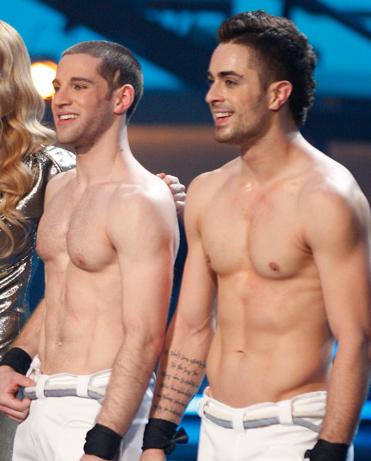Oh those irrepressible kids on So You Think You Can Dance, Canada (SYTYCDC)? Too sexy. Between one- and one-and-half-million viewers tune in each week to watch hard-bodied twentysomethings strut their stuff (the winner is announced Sun, Dec 7 on CTV). It’s the number one Canadian-made show on television, even beating out Hockey Night in Canada some weeks.
How glorious. The country is awash in dance. Which makes me think of football… I’m queer that way.
At heart SYTYCDC is a celebration of youthful bodies, the simple joy of incredible athletes moving fantastically. It’s also a very charged exploration of sex — that’s always been the soul of dance, sexual energy spinning bodies together.
James Kudelka, the former artistic director of the National Ballet of Canada, once told me, “Ballet is safe sex — sex with the condom already rolled on.” It’s a reference both to ballet tights that leave little to the imagination and to ballet getting away with outrageous sexual situations that its audiences wouldn’t tolerate in other formats.
The same holds true for SYTYCDC. It’s so popular because sex sells, especially sex that young audiences can try on for size with little risk and plenty of sizzle.
From the queer camaraderie of the judges and choreographers (everyone flirts with everybody — former ballet star Rex Harrington was particularly shameless) to the indiscriminate Quebexuality of those French boys, this is a libertine world of free love. It’s all very gay.
And yet the show can’t stray from its relentlessly heterosexual pairings. If only we could watch finalists Nico Archambault and Miles Faber get it on. For such man-on-man action I usually turn to another dance form, football.
Yes, football is dance — a mix of choreographed and improvised movement that tells a story, climaxing in a collective catharsis. Try watching football with those blowhard announcers on mute and your stereo full blast — any music will do — and tell me football’s not a joy-filled dance form (granted, there are other darker stories being told — competition, war, machismo — but that’s dance too).
Watching the Grey Cup at a sports bar, I overheard two straight men talking. “You got to love football,” one said. “Girls can’t fake liking it. Not like this one girlfriend of mine who always came to basketball games. But she didn’t have a clue. And I was like, ‘What are you doing here?'”
Contact sports and dance proper share a profound disconnect — their fans cannot understand each other. The gender — and sexuality — divide is pretty rigid.
Lack of exposure means that, to novices, dance and football are just meaningless piles of bodies flapping around. It takes time to learn what to look for. After two quarters of lacklustre football Henry Burris connects with Brett Ralph for Calgary’s only Grey Cup touchdown. Beauty. After two movements of strong but aseptic ballet guest dancer Ethan Stiefel literally takes flight in the National’s Symphony in C. Breathtaking. With dance, like football, you have to learn patience, how to wait for the magic.
A show like SYTYCDC can’t help but improve basic dance literacy. Great.
Balanchine famously said, “Ballet is woman.” Over the course of the 20th century that changed as male dancers and masculine athleticism and eroticism gained equal footing. The National’s superb fall season offered a concise illustration of this, beginning with Balanchine’s 1947 Symphony in C — an abstract neoclassical showcase of female beauty — and ending with gay choreographer John Neumeier’s The Seagull from 2002 — a post-modern story of an artist and his male muses. Contemporary companies like Toronto Dance Theatre switchup pairings so often that gender is a non-issue.
But the divide survives. Back on TV Harrington overreached when he exclaimed to Archambault, “You are the reason boys put down their hockey sticks and start dancing!” Uh, Rex. Check out your studio audience: Ninety percent screaming teenage girls with a smattering of shy-looking boys. Hopefully that large home audience is more male — whether watching in secret or not.
Dance is one of the weirdest, wildest art forms. It can be totally abstract and yet only expressed through bodies. Dance makes you think in moving ways.


 Why you can trust Xtra
Why you can trust Xtra


